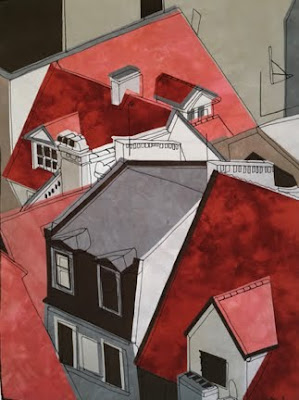Once again, I chose to work with neutral colours, but this time, instead of using a stripe format, I'm playing with small shapes and grouping them into something more monumental. I paid particular attention to dark and light and range of contrast.
 |
| #1 was the lightest piece, a work in progress. It began with a buff-coloured background. |
Most of these shapes were made with collage, but paint was also used, often to soften the edges. Line, stamping and stencilling also came into play. I made a point of including some "breathing space" as well as busier areas of interest. All pieces measure 16" x 16" and are on good quality, Stonehenge paper.
One of the requirements of this class is to comment on the work of our classmates. Thanks to some great suggestions from the instructor and other participants, I was able to push some of the work a little further. You can see some of the transformations below, in numbers 2 through 5.
 |
| #2a began with a slightly darker background, and includes a few touches of darker pigment. It was transformed into... |
 |
| ... #2b, the result of a 180 rotation, a lot of veiling with white paint, and the introduction of line to suggest additional shapes. It still looks like two opposing masses, but is more subtle. |
 |
| #3a began with a medium brown background, and most of its elements are in the middle range of value. It was changed into... |
 |
| ... #3b, the result of additional collage bits, veiling with dark paint, and a lighter background. |
 |
| #4a began with a background of medium-value gold. It includes elements that are very dark and very light. It was changed into... |
 |
| ... #4b, the result of more veiling with white paint and more linework with charcoal, to suggest additional shapes. |
 |
| #5a began with a black background. There are hints of colour in some of the shapes: yellow, blue, green and red, as well as the neutrals. It was changed into... |
 |
| ... #5b, the result of a 180-rotation, veiling with white paint, and additional shapes created by charcoal linework. |
 |
| #6 is the darkest in the series. It began with a medium grey background, and includes sepia, Payne's grey, black, and a touch of white. I haven't (yet) had another go at it. |
Will report on Lesson 3 soon!






















